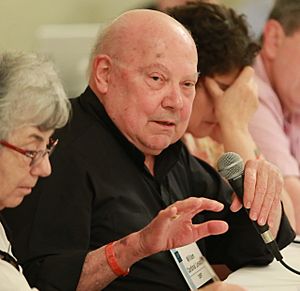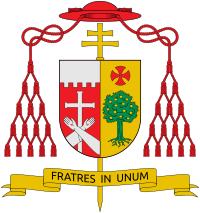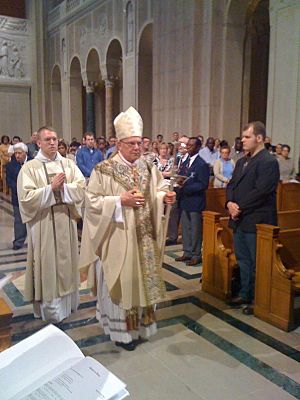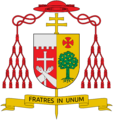William Levada facts for kids
Quick facts for kids His Eminence William Joseph Levada |
|
|---|---|
| Prefect of the Congregation for the Doctrine of the Faith | |

Cardinal Levada in 2015
|
|
| Appointed | May 13, 2005 |
| Reign ended | July 2, 2012 |
| Predecessor | Joseph Ratzinger |
| Successor | Gerhard Ludwig Müller |
| Other posts |
|
| Orders | |
| Ordination | December 20, 1961 |
| Consecration | May 12, 1983 by Timothy Manning |
| Created Cardinal | March 24, 2006 |
| Rank |
|
| Personal details | |
| Born | June 15, 1936 Long Beach, California, United States |
| Died | September 26, 2019 (aged 83) Rome, Italy |
| Nationality | American |
| Denomination | Roman Catholic |
| Parents |
|
| Previous post |
|
| Motto | Fratres in unum ('Brothers in unity', Psalm 133:1) |
| Styles of William Joseph Levada |
|
|---|---|
 |
|
| Reference style | His Eminence |
| Spoken style | Your Eminence |
| Informal style | Cardinal |
| See | San Francisco (emeritus) |
William Joseph Levada (June 15, 1936 – September 26, 2019) was an American cardinal in the Catholic Church. From 2005 to 2012, he was the Prefect of the Congregation for the Doctrine of the Faith. This is a very important job in the Roman Curia, which is like the Pope's main government. He was the highest-ranking American in this group. Before that, he was an Archbishop in Portland, Oregon (1986–1995) and San Francisco, California (1995–2005). Pope Benedict XVI made him a cardinal in 2006.
Contents
Early Life and Education
William Joseph Levada was born in Long Beach, California. His parents, Joseph and Lorraine, were from Concord, California. His family had roots in Portugal and Ireland. They moved to the San Francisco Bay Area in the 1860s.
He grew up in Long Beach and Houston, Texas. He went to St. Anthony High School and then St. John's Seminary in Camarillo, California. A classmate at St. Anthony High School was George Hugh Niederauer, who later took over Levada's role as archbishop of San Francisco.
From 1958 to 1961, Levada studied in Rome at the Pontifical North American College. He also studied theology at the Pontifical Gregorian University. He became a priest on December 20, 1961. Archbishop Martin John O'Connor ordained him in St. Peter's Basilica.
Becoming a Priest
From 1961 to about 1966, Levada worked in churches in the Roman Catholic Archdiocese of Los Angeles. He taught high school and worked with college students.
He then went back to Rome to continue his studies. He earned a special degree in sacred theology. In the early 1970s, he taught theology at St. John's Seminary. He also became the first Director of Continuing Education for the Clergy. He received the title of Monsignor, which is an honor for a priest.
From 1976 to 1982, Levada worked for the Congregation for the Doctrine of the Faith (CDF) in the Vatican. This is an important office that helps protect Catholic teachings. He worked under three popes: Pope Paul VI, Pope John Paul I, and Pope John Paul II. He also worked under two leaders of the CDF, including Joseph Ratzinger.
In 1982, Cardinal Timothy Manning asked Levada to lead the California Catholic Conference of Bishops. This group helps guide Catholic activities in California.
Becoming a Bishop
Helping in Los Angeles
On March 25, 1983, Levada became an auxiliary bishop of Los Angeles. An auxiliary bishop helps the main bishop. He was consecrated (made a bishop) on May 12, 1983. In 1984, he became a special helper for Santa Barbara County. In 1986, he helped organize the archdiocese's main offices.
Leading in Portland
On July 1, 1986, Levada became the Archbishop of Portland in Oregon. As archbishop, he helped improve Mount Angel Seminary. He also worked to help Catholic Charities and the Hispanic Catholic community. He also helped renovate St. Mary's Cathedral.
In 1987, he joined a special committee. This committee helped create a new Catechism of the Catholic Church. A catechism is a book that explains the main beliefs of the Catholic Church.
Leading in San Francisco
On August 17, 1995, Levada became the coadjutor archbishop of San Francisco. This means he was set to take over the role. On December 27, 1995, he became the Archbishop of San Francisco.
In November 2000, Levada became a member of the Congregation for the Doctrine of the Faith again. This was a part-time job, so he could stay in California.
He also became a co-leader for talks between Anglican and Roman Catholic churches in the United States. In November 2003, he became chairman of the United States Conference of Catholic Bishops Committee on Doctrine. He left this role in 2005 when he moved to Rome.
As Archbishop of San Francisco, he also held leadership roles in two important Catholic orders: the Equestrian Order of the Holy Sepulchre of Jerusalem and the Sovereign Military Hospitaller Order of St. John of Jerusalem of Rhodes and of Malta.
In 2013, Levada was one of the cardinals who voted for the new Pope in the 2013 papal conclave.
Prefect of the Congregation for the Doctrine of the Faith
On May 13, 2005, Pope Benedict XVI chose Levada to take his place as Prefect of the Congregation for the Doctrine of the Faith. This is a very important job in the Catholic Church.
On March 24, 2006, Pope Benedict XVI made Levada a cardinal. He was first a cardinal deacon and later a cardinal priest.
As prefect of the CDF, Cardinal Levada also led other important groups. These included the Pontifical Biblical Commission and the International Theological Commission. He was also a member of many other Vatican departments. These departments help the Pope with different parts of the Church's work. On January 5, 2011, he joined the new Pontifical Council for the Promotion of the New Evangelisation.
Pope Benedict accepted his retirement from this role on July 2, 2012. Gerhard Ludwig Müller took over his position.
Leading the Ecclesia Dei Commission
Cardinal Levada also led the Pontifical Commission Ecclesia Dei. This group works to bring traditional Catholic groups closer to Rome. It also helps regulate the celebration of older Latin Masses.
On May 13, 2011, a document called Universae Ecclesiae was released. This document helped explain how to use the older Latin Mass. Cardinal Levada signed this document.
His Views
Cardinal Levada's views generally followed the traditional teachings of the Catholic Church.
Views on Marriage and Partnerships
In 1997, the city of San Francisco passed a law. It said that companies must offer the same benefits to domestic partners as to married couples. This was to help gay couples and unmarried heterosexual couples. Levada said this went against Catholic teaching about marriage. He found a way for the archdiocese to follow the law without changing its view on marriage. He said unmarried employees could choose any person living with them as a beneficiary.
In 2005, Levada led a march in San Francisco. The march was to show disagreement with same sex marriage. He believed that only marriage between a man and a woman forms the "bedrock of the family."
In 2006, Levada stated that the Archdiocese of San Francisco should be careful about allowing gay couples to adopt children locally. The San Francisco Board of Supervisors disagreed with his view.
Views on Language in Church Texts
Levada helped edit the updated Catechism of the Catholic Church in 1987. He did not agree with using gender-inclusive language in the English translation. His views were followed, and the 1994 version kept traditional gendered words. He also wrote the glossary for the second edition of the catechism.
Views on Disagreement with Church Teachings
Levada wrote about Catholics who disagree with Church teachings. He said that Catholic theology does not support public disagreement with clear, official Church teachings.
Interfaith Dialogue
Levada supported talking and understanding between different religions. This is called interfaith dialogue.
Rabbi David Rosen said that Levada believed it was important to talk with Jews. He thought this was valuable even without trying to convert them. Levada also made a difference between "witnessing" (sharing the New Testament) and trying to convert people, which he thought was wrong.
In 2002, Levada spoke at the University of San Francisco. He said that if both Islam and Christianity see themselves as worldwide religions, it means they have a chance to learn more about each other's faith.
Tridentine Mass
In 1999, some traditional Catholics complained. They said Levada did not allow Tridentine Masses to be celebrated publicly in his archdiocese. They felt this went against Pope John Paul II's rules.
Retirement and Death
Levada retired in July 2012. He lived at St Patrick Seminary in Menlo Park, California.
William Joseph Levada passed away on September 26, 2019, in Rome.
Images for kids
See also
 In Spanish: William Levada para niños
In Spanish: William Levada para niños



